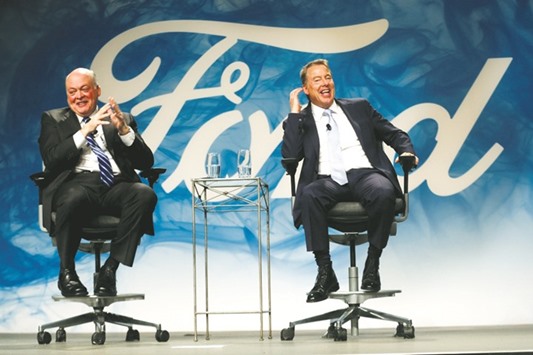Ford Motor Co is replacing embattled chief executive officer Mark Fields with Jim Hackett, a turnaround specialist who has been leading the automaker’s moves into self-driving cars and ride sharing.
Fields, 56, is retiring and Hackett will move up from his position as head of Ford’s Smart Mobility unit, according to a statement. Hackett, 62, revived office-furniture maker Steelcase as CEO from 1994 to 2014.
Fields came under pressure from Ford’s board this month ahead of an annual shareholder meeting where investors excoriated management for a poorly performing stock price. Ford shares fell 37% during Fields’s almost three-year tenure, dropping the company’s market capitalisation behind Tesla’s. The automaker announced a voluntary buyout programme last week to show it was moving to cut costs.
“It’s surprising how quickly Fields is being replaced,” said Stefan Bratzel, director of the Center of Automotive Management at the University of Applied Sciences in Bergisch Gladbach, Germany.
“Ford isn’t exactly in crisis, but this development shows that shareholder value is more in focus,” even as carmakers face pressure to invest in technology where the payoff is uncertain.
Ford scheduled a news conference for 9:45am at its headquarters in Dearborn, Michigan.
Hackett joined Ford’s board of directors in 2013 and was appointed chairman of Ford Smart Mobility in March 2016. The unit was formed to accelerate Ford’s foray into emerging mobility services.
For two decades, Hackett guided Grand Rapids, Michigan-based office furniture maker Steelcase. He was recognised for predicting the office landscape would shift away from cubicles to an open-space environment and transformed the traditional manufacturer of office furniture, according to a profile on Ford’s website.
Hackett led a major reorganisation that involved deep cuts in Steelcase’s workforce, including personally pink-slipping the best man from his wedding, according to Automotive News. After Steelcase, Hackett served as interim athletic director of the University of Michigan at a time of turmoil and hired Jim Harbaugh to return the football team to its winning ways.
Ford’s board scheduled extra meeting time to drill Fields on his plans for reversing the company’s fortunes, a person familiar with the discussions said earlier this month. The CEO has been pouring billions into self-driving cars and ride-sharing experiments as its traditional-car business has struggled more than General Motors Co with a slowing US market.
“Ford’s reputation with the investor community with respect to the secular pressures is that they are throwing a lot of things at the wall,” Joe Spak, an analyst at RBC Capital Markets, wrote in a report yesterday. “They are doing a lot. Some of it may be smart. But the overall communication hasn’t been great. A simpler message may be needed.”
Fields joined Ford in July 1989 and helped steer its businesses through several tough situations before he was named to the top job in July 2014.
In 2000, Fields became CEO of Mazda Motor Corp, in which Ford had a controlling stake at the time. He led a turnaround at Mazda with several Ford executives with whom he later worked to revive the US automaker’s North American business.
After being promoted to chief operating officer in December 2012, Fields took over as CEO from Alan Mulally, the former Boeing Co executive who led Ford through the global economic crisis and avoided the bailouts and bankruptcies that befell GM and Chrysler.
Fields was leading an overhaul of Ford’s business model so the company could take on self-driving cars from the likes of Alphabet’s Waymo and Uber Technologies. He warned the cost of investing in new technologies would reduce profits last year and this year before rebounding in 2018.
Ford’s first-quarter adjusted earnings fell 42%, while GM appears on pace for another record annual profit. Net income at Ford plunged 38% last year.

Ford Motor executive chairman Bill Ford (right) and James Hackett answer questions from the media after announcing Hackett was named as Ford Motor Company president and CEO, succeeding Mark Fields, in Dearborn, Michigan yesterday.


